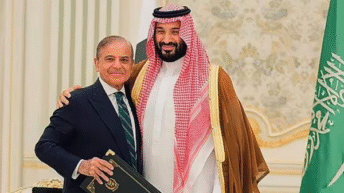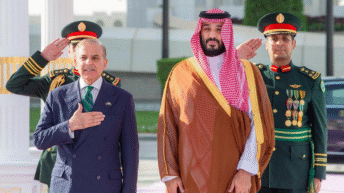
The person who spoke of Islam as the new global colonial power was Iran’s revolutionary spiritual leader Ayatollah Khomeini. He asserted in his sermons that Islam was bound to be the universal religion, bringing in a new way of life and social behaviour presented in Islamic (Shi’ite) theological works. Perhaps he considered propagation, not action, as the method for popularising Islamic faith throughout the world, the Western world in particular.
Islam is an ideological antithesis of the concept of diversity. It has used all instruments of enhancing its ideological outreach. Some of its fundamental principles of orthodoxy have remained the fountainhead of power such as blind faith, fragility of logic, absolute submission to religious authority, adherence to the principle of takiya or disguise, adherence to jamhur (congregation), and conduct of daily life according to sharia and the usagesof Jema’ah (congregation). Even tasavvuf (mysticism) is denigrated by many orthodox clerics as un-Islamic.
In kalame sufiyane shoom nist/ mathnavi-e Maulavi-e Rum nist
(This narrative is not the sullen narrative of the Sufis/ It is not the Mathnavi of Maulana Rum)
Writes Jelal ul Din.
After the Arab conquests, a major task before the conquerors was how to culturally Islamicise the non-Arab races and integrate them into the broad Semitic ethos. The most prominent and powerful of these non-Semites were the people of Aryan stock inhabiting large swaths of Central Asian, South Asian, and the Mediterranean lands. Physical conquest of these regions was complete, but propagation of the faith and conversion were serious undertakings requiring attention. How could these be tackled?
This was the reason why the great Islamic historian and philosopher Ibn Khaldun (14th century) wrote in al-Muqaddimah (Prolegomena) that the Arabs must understand the fact that many of the conquered non-Islamic communities they had integrated into their fold, had to be assimilated into the new civilisation. The task was not that simple because they were the inheritors of great civilisations. Therefore, Ibn Khaldun emphasised that the Arabs need to find ways of addressing socio-cultural fundamentals amicably not to alienate the non-Muslim and newly converted subjects of the Islamic realm. Dispassionate historians will adjudge them. Nevertheless, the clash of civilisations dogging the contemporary societies is alarming.
The problem became somewhat complicated with the proselytized communities of Indo-European stock, especially in Southern European lands where Arab conquerors had made deep inroads. As a result, we had the crusades and Salahu’d Din Ayyubi, who remains to this day one of the most celebrated warriors of Islam.
Central Asia, Iran, Afghanistan, the Indian sub-continent, Turkistan, and Southeast Asian regions, had their share of civilizational clashes. Constantinople, standing on the frontier between Europe and Asia had special significance because geographically, it was located at the point of convergence of two civilisations.
Distanced from their cultural roots, many Eurasian societies embraced a new civilisational format just because they had lost the faith of their ancestors and clung to a faith ethnographically alien to them. It nursed in them a lurking inferiority complex —- a vestige from the days when Islam had entered their lives. Circumstantially, they became the prisoners of the urge to be “more royalist than the king.” The desire to prove the genuineness of their faith transformed many of them into hardened fanatics, harbouring hatred against their forbears and their non-Islamic kindred. They find everything about their original religions negative and reprehensible. Iqbal said “jo naqsh kohan aye nazar usko mita do” ( destroy everything that belongs to antiquity), although he may also have meant this for practices of Islam he regarded as outdated and backward.
The creation of a new homeland on the Indian subcontinent in 1947 is the consequence of twelve centuries of civilisational estrangement on the Indian sub-continent; it has to be understood against this background. The nearer home example is of Kashmir.
This phenomenon attained varying complexion from one region to another. In Iran, Central Asia, and Afghanistan, many who fought the invaders and resisted conversion were killed or had to leave their native lands and look for safe havens elsewhere. The Parsees of Iranian origin and the Pandits of Kashmir are glaring examples. We could include more groups in the category, such as the Armenians, Syrian and Coptic Christians, Assyrians, Yezidis, and others.
However, the exodus of Kashmiri Pandits is a peculiar case, which reveals the deep traces left by several centuries of foreign (Muslim and Christian) domination, which injected a mindset of servitude into the Hindu psyche. Nearly seven hundred thousand personnel of Indian military and para-military forces deployed in Kashmir could not save a few hundred Pandir families from ethnic cleansing. They remained confined to their barracks in the Badami Bagh cantonment. Such is the helplessness of Hindu mindset that despite the cold-blooded murder of more than a thousand Kashmiri Hindus and finally their mass exodus from their ten-thousand-year-old homeland, no government, no political party and no civil rights organisation dared to set up a commission of enquiry into the decimation and destruction of the small religious minority of Kashmiri Pandits who amounted to 3% of the total population of Kashmir. The Indian state miserably failed to implement the clauses of the Constitution that guarantee the protection of ethno-religious minorities and of their rights and properties..
The second category of autochthonous people resisted the onslaught and withstood atrocities inflicted – now called violations of human rights -, they did not depart from their original places of residence, and made the invaders recognise their claims to land and life in their native countries. India is a fine example of this state of affairs.
A frustrating outcome of this Status Quo is the frequent occurrence of incidents of violence and ntimidation. Acquiescence to the claims of the aggressor was diluted as “Ganga-Jamuna tehzib”, meaning harmonious living, and “Indian secularism”. In Kashmir was given the rosy name of Kashmiriyat, to make it nnocuous, so much so that late Indian Prime Minister Atal Bihari Vajpayee coined the triad of “insaniyat, jamhuriyat, Kashmiriyat “ to define the desired coexistence between communities in the State. He indirectly wanted to say that Indian rulers had neglected these three fundamental rules for dealing with Kashmiris. This historically unsubstantiated theory ignores the persistent demand of Muslims for a separate state of their own, in Kashmir as in many other places
The third category of Islamic societies defines those nations that tenaciously held on to their indigenous pre-Islamic symbols, traditions, and ways of life. Indonesia is perhaps the best example.
Contemporary Islam, however blurs those three categories due to various factors. The defeat of the decadent Ottoman Empire in the first World War, the liquidation of the tottering Mughal Empire of India by the British colonial power in the second half of the 19th century, the rise of patriotic forces under Kemal Ataturk in Turkey and Reza Shah Pahlavi in Iran in the early 20th century, the emergence of Jama’at-i-Islami, and other Muslim radical organizations contemporary with the rise of the RSS in India led to the awakening of long-suppressed Islamic nations in West and south Asia. The mass movement against the three Khanates in Central Asia in the early nineteen hundreds, followed by the impact of the Bolshevik Revolution, pushed the freedom movement in Central Asia away from its religious underpinning towards a quest for modernity. Secular economic and social development transformed Central Asian Muslim societies. That is the reason why the Central Asian Muslims have remained mostly immune to the jihadist ideology that engulfed the Ummah in West and South Asia and North Africa.
The discovery of hydrocarbon deposits in the Gulf has been defined as both the cause of the fortune and misfortune of the Muslim world. In 1905, the British found oil in the Gulf and with that began the sordid story of the exploitation of Iran and Arab states. World War II had turned the US into a ‘superpower’ which sought to achieve a monopoly over oil production, exploitation, and distribution. This became the main cause for widespread hatred of the US and its European colonial accomplices in Islamic lands. As a precaution, the US engineered divisions between Arab states according the colonial imperialist theory of divide and rule. The situation in Palestine results from this policy.
The crisis has deepened because of the inability of the Muslims to live in harmony with other communities. They are told that Islam is essentially a revolt against millennial polytheist superstitions and idolatries, and they are enjoined to wipe out all other religious denominations and make Islam the only path for mankind.
The creation of a separate homeland in the Indian sub-continent was the result, first of the unflinching conviction of Muslims that they are born to rule and spread Islam all over the globe. The Kashmir issue is the cumulative outcome of the crescendo of Islamic resurgence in reaction to the dismemberment of the Ottoman Empire at the hands of European colonial powers. Gandhi lent full support to the Ali Brothers, endorsing the Khilafat movement, and lamenting the demise of the autocratic Ottoman Empire. Nehru applied the same reasoning to the downfall of the Mughals half a century earlier. Gandhi and his colleagues in the Congress succumbed to the entreaties of Indian Islamists and openly supported the Khilafat movement, an orthodox Sunni Islamic reactionary force.
This background scenario becomes transparent when we dispassionately analyse the beginning of a radical movement in Kashmir around 1920. Islam is no longer confined to the land of its birth and the territories its warriors gradually conquered. From West Asia, North Africa, and the Indian-subcontinent, it has spread to nearly 153 countries of the world, encompassing Europe, the Americas, and even Australia and New Zealand. This is what Ayatollah Khomeini had predicted in the nineteen sixties. The rise of Islam in our century bids adieu to Western liberal democracy. US President Donald Trump speaks publicly about this ongoing process but yet he also welcomes and partners with a Pakistani military ruler who openly champions Islamic radicalism and its global expansion.






Add comment